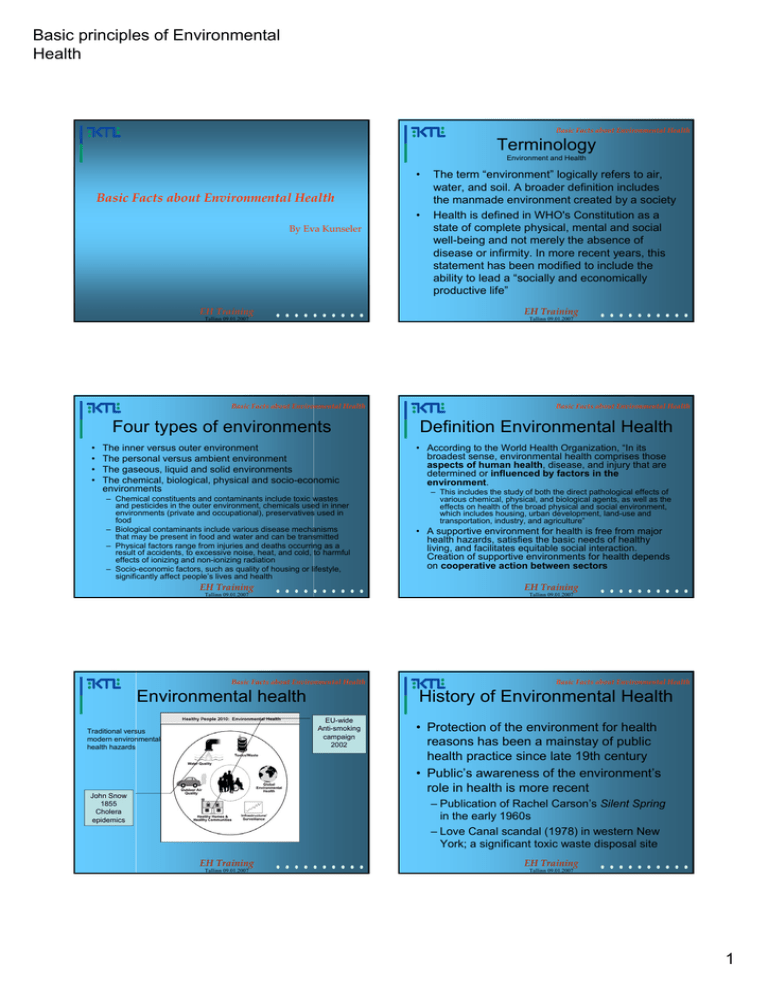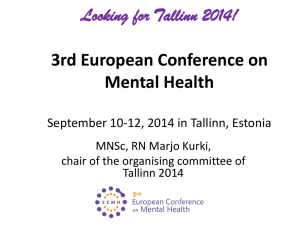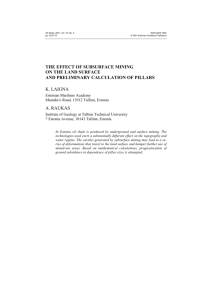Basic principles Of Environmental Health
advertisement

Basic principles of Environmental Health Basic Facts about Environmental Health Terminology Environment and Health • Basic Facts about Environmental Health • By Eva Kunseler EH Training EH Training Tallinn 09.01.2007 Tallinn 09.01.2007 Basic Facts about Environmental Health Four types of environments • • • • The inner versus outer environment The personal versus ambient environment The gaseous, liquid and solid environments The chemical, biological, physical and socio-economic environments – Chemical constituents and contaminants include toxic wastes and pesticides in the outer environment, chemicals used in inner environments (private and occupational), preservatives used in food – Biological contaminants include various disease mechanisms that may be present in food and water and can be transmitted – Physical factors range from injuries and deaths occurring as a result of accidents, to excessive noise, heat, and cold, to harmful effects of ionizing and non-ionizing radiation – Socio-economic factors, such as quality of housing or lifestyle, significantly affect people’s lives and health EH Training Definition Environmental Health • According to the World Health Organization, “In its broadest sense, environmental health comprises those aspects of human health, disease, and injury that are determined or influenced by factors in the environment. – This includes the study of both the direct pathological effects of various chemical, physical, and biological agents, as well as the effects on health of the broad physical and social environment, which includes housing, urban development, land-use and transportation, industry, and agriculture” • A supportive environment for health is free from major health hazards, satisfies the basic needs of healthy living, and facilitates equitable social interaction. Creation of supportive environments for health depends on cooperative action between sectors Tallinn 09.01.2007 Basic Facts about Environmental Health Environmental health Basic Facts about Environmental Health History of Environmental Health EU-wide Anti-smoking campaign 2002 John Snow 1855 Cholera epidemics Basic Facts about Environmental Health EH Training Tallinn 09.01.2007 Traditional versus modern environmental health hazards The term “environment” logically refers to air, water, and soil. A broader definition includes the manmade environment created by a society Health is defined in WHO's Constitution as a state of complete physical, mental and social well-being and not merely the absence of disease or infirmity. In more recent years, this statement has been modified to include the ability to lead a “socially and economically productive life” • Protection of the environment for health reasons has been a mainstay of public health practice since late 19th century • Public’s awareness of the environment’s role in health is more recent – Publication of Rachel Carson’s Silent Spring in the early 1960s – Love Canal scandal (1978) in western New York; a significant toxic waste disposal site EH Training Tallinn 09.01.2007 EH Training Tallinn 09.01.2007 1 Basic principles of Environmental Health Basic Facts about Environmental Health Definition Public Health Basic Facts about Environmental Health Determinants of Health • The approach to medicine that is concerned with the health of the community as a whole • The mission of public health is to "fulfill society's interest in assuring conditions in which people can be healthy" The three core public health functions are: – The assessment and monitoring of the health of communities and populations at risk to identify health problems and priorities – The formulation of public policies designed to solve identified local and national health problems and priorities – To assure that all populations have access to appropriate and costeffective care, including health promotion and disease prevention services, and evaluation of the effectiveness of that care EH Training EH Training Tallinn 09.01.2007 Tallinn 09.01.2007 Basic Facts about Environmental Health Environmental and Occupational health • Environmental health is the segment of public health that is concerned with assessing, understanding and controlling the impacts of people on the living and global environment and the impacts of the environment on them • Occupational health is the segment of public health that is concerned with protection of health and well-being of people engaged in work or employment from hazardous factors in the occupational environment • Similar source-to-effect approach but huge differences in study population, exposures and the variety of sources and pollutants EH Training Tallinn 09.01.2007 Basic Facts about Environmental Health Definition of Risk • A hazard is a factor or circumstance that may under some circumstances be harmful • Risk includes the probability of harm times consequences – "What can go wrong?" is usually answered in the form of a "scenario" – "How likely is it?" can be answered in terms of the available evidence to quantify the probability and the uncertainties involved. In other situations, there may be little or no data and a predictive approach for analyzing probability and uncertainty will be required. – "What are the consequences?" can be answered for each scenario by assessing the probable range of outcomes given the uncertainties • Different types of risks – Real future risk as disclosed by the fully matured future circumstances when they develop – Statistical risk, as determined by currently available data – Projected risk, as analytically based on predictive models – Perceived risk, as intuitively seen by individuals • In the context of public health, risk assessment is the process of quantifying the probability of a harmful effect to individuals or populations from certain human activities EH Training Tallinn 09.01.2007 Basic Facts about Environmental Health Models of environment and public health Environment Public Disease Death Public health intervention model: Prevention of development of disease Environment Public Disease Death Environmental stewardship model: Prevention of environmental degradation and resulting impacts on health EH Training Tallinn 09.01.2007 Basic Facts about Environmental Health Types of environmental health risks • Environment and health causal link supported with evidence: Passive smoking and occurrence of lung cancer • Environment and health causal link supported with ambiguous evidence: BSE (bovine spongiforme encefalopathie or mad cow disease) and variant Creutzfeldt-Jakob disease • Newly identified environment and health causal link not supported with evidence: GMO (genetically modified organism) and adverse health effects EH Training Tallinn 09.01.2007 2 Basic principles of Environmental Health Basic Facts about Environmental Health Basic Facts about Environmental Health EH Framework explained Environmental cause-and-health effect framework • Driving Forces: Human activities create conditions in which EH threats can develop or be averted • Environmental pressure may increase or decrease • State of the environmental quality influences human exposures and health effects • Exposure Action can be taken at each step in the framework – Concentration of the pollutant in the exposure medium • Environmental monitoring – The length of exposure time Powerful guide to designing cost-effective and timely interventions • Questionnaire surveys – The available dose inside the body, depending e.g. on activity pattern, exposure circumstances (temperature, humidity) • Biomonitoring data WHO 1995 • Effect: Specific health effects are caused by exposure to mixtures of pollutants and psychosocial factors EH Training EH Training Tallinn 09.01.2007 Tallinn 09.01.2007 Basic Facts about Environmental Health Basic Facts about Environmental Health Importance of EH hazards Environmental health in practice • Environmental Health experts aim to understand the various ways in which humans interact with their environment – – – – • Determination of the source and nature of each environmental pollutant or stressor Assessment of how and in what form that pollutant comes into contact with people Measurements of the resulting effects Application of controls when and where appropriate Causality between a certain pollutant and particular health effect is difficult to detect / assess: – – Infinite variety of pollutants and stressors Possible synergistic effect of different pollutants and stressors • • More information is available through advances in data collection and surveillance systems, leading to a growing concern about the health effects of environmental factors Two topics of particular interest: – Vulnerability to EH hazards: variation with age and health status, genetic make up, diet and well-being – Inequity: Human exposure is not evenly distributed, depending on population density and related presence of human and natural activities EH Training EH Training Tallinn 09.01.2007 Tallinn 09.01.2007 Basic Facts about Environmental Health Children’s environmental health http://www.euro.who.int/childhealthenv • – – – – – Outdoor Air Quality and Health http://www.euro.who.int/air • Adverse health effects from air pollution Vulnerable group – Basic Facts about Environmental Health Developing biological system Greater exposure Toddler behaviour Immature metabolism Early exposures Incomplete understanding about children’s risks EH Training Tallinn 09.01.2007 – – – – Lung cancer and chronic lung disease Decreased lung function Respiratory infections, asthma Allergies • Air pollutants – – – – – Sulfur dioxide (SO2) Particulate matter (PM2,5 and PM10) Nitrogen oxides (NOx, NO2) Volatile organic compounds (VOCs) Metals: cadmium, mercury, lead, copper EH Training Tallinn 09.01.2007 3 Basic principles of Environmental Health Basic Facts about Environmental Health Basic Facts about Environmental Health Water and Sanitation Outdoor Air Quality and Health(2) • http://www.euro.who.int/watsan • Sources of air pollution – Stationary: Fossil fuel power plants (SO2), combustion plants and industrial processes (PM, NOx) – Mobile: Road traffic (NOx and VOCs) • – Water-borne disease, e.g acute gastrointestinal disease, cholera – Water-contact disease, e.g worms – Water-insect related disease, e.g malaria – Water-wash disease e.g. lack of hygiene Exposure – Outdoor air: PM, NOx, VOCs, SO2 – Food chain: cadmium and mercury from soils to food chains – Water: lead and copper from water supply systems EH Training Health effects from polluted drinking and bathing water • Water pollutants – – – – Tallinn 09.01.2007 Microbial contaminants Nitrates Pesticides Other chemicals EH Training Tallinn 09.01.2007 Basic Facts about Environmental Health Water and Sanitation (2) • Sources – – – – • Toxic chemicals in drinking-water supplies, e.g. lead Sludge and human and animal waste Agricultural use of pesticides and nitrates Acidic precipitation Exposure via contaminated ground- and surface water – – – – Inadequate treatment of sewage Discharge of manure Breakdown in treatment operations Contamination during distribution as result of accidents or improper design of the distribution system EH Training Basic Facts about Environmental Health Solid wastes and Soil pollution • Health effects – Cancer – Infectious diseases – Poisoning • Pollutants – Pathogenic micro-organisms – Metals – Organic chemicals EH Training Tallinn 09.01.2007 Tallinn 09.01.2007 Basic Facts about Environmental Health Basic Facts about Environmental Health Noise and Health Solid wastes and Soil pollution • Sources http://www.euro.who.int/noise • Health effects – Industrial waste – Municipal waste – Medical or radioactive waste • Exposure through leaking / inadequate landfills – Contaminated ground water – Hand-mouth behaviour of children – – – – – long-term sleep disturbance cardiovascular problems pain and hearing fatigue and impairment annoyance hormonal responses (stress hormones) and their possible consequences on human metabolism (nutrition) and immune system – performance at work and/or school decrements • Excessive noise levels EH Training Tallinn 09.01.2007 EH Training Tallinn 09.01.2007 4 Basic principles of Environmental Health Basic Facts about Environmental Health Noise and Health (2) Basic Facts about Environmental Health Radiation – UV, radon, non-ionizing http://www.who.int/uv/en/ • • Sources – Road traffic – Aircraft – Neighbourhood (school, work) Health effects – – • Radiation pollutants – • Exposure Ionizing radiation: chemical and biological changes, e.g fever, nausea, skin cancer, thyroid cancer Non-ionizing radiation: ambiguous, e.g headache, brain cancer, leukemia Ionizing radiation • • • • • – Daytime – Nighttime – Non-ionizing radiation • • EH Training Natural background cosmic and terrestrial radiation Ultraviolet radiation Nuclear power production – processing uranium Radon in (badly ventilated) buildings Medical and dental care – X ray and radioactive material Infrared Laser, Microwave radiation Electric Magnetic Fields EH Training Tallinn 09.01.2007 Tallinn 09.01.2007 Basic Facts about Environmental Health Basic Facts about Environmental Health Food safety Radiation (2) • • Sources – – – – http://www.euro.who.int/foodsafety Natural: rock and sun (reduced ozone layer) Medical and dental care Nuclear power production Electronic and telecommunication industries • Exposure – – • – Occupational – Residential indoor air – Outdoor sun bathing Health effects – Poisonings: numbness, paralysis, neurological symptoms, death Infections: vomiting, abdominal pain, fever, diarrhea, nausea, malaise Miscellanous: methemoglobinemia, hypertension, gastric injury, osteoporosis Pollutants – – Biological agents: bacteria, viruses, moulds, antibiotics, parasites, toxins, hormones Chemical agents: lead, cadmium, mercury, sodium, phosphates, nitrites, nitrates, organic compounds EH Training EH Training Tallinn 09.01.2007 Tallinn 09.01.2007 Basic Facts about Environmental Health Basic Facts about Environmental Health Transport and Health Food safety (2) • – – – • Throughout the foodchain: growing, processing, preparation, storage Foodborne parasites, bacterial infections (e.g. salmonella), viral infections (e.g. hepatitis A), natural toxins or toxins produced by bacteria or viruses Natural chemical components or chemical deposition or uptake from air, water and soil Exposure – Consumption of contaminated food or water • • • http://www.euro.who.int/transport • Sources Inadequate cooking Improper storage or holding temperature Poor personal hygiene EH Training Tallinn 09.01.2007 Health effects – – – – • Injuries and deaths Respiratory disease Obesity / overweight Annoyance Hazards / Sources / Exposure – Air pollutants: NOx, PM – Accidents – Road traffic noise EH Training Tallinn 09.01.2007 5 Basic principles of Environmental Health Basic Facts about Environmental Health Basic Facts about Environmental Health Indoor Air and Health Housing and Health http://www.euro.who.int/tobaccofree http://www.euro.who.int/Housing • Health effects • Health effects – Lung cancer – Sick building syndrome – Allergy / Irritation /Discomfort – Loss of physical, social and mental wellbeing • Lack of privacy, disturbance (noise, waste) • Hazards / Sources / Exposure • Pollutants – Outdoor origin – Indoor origin: NO2, tobacco smoke (carcinogens), lead, asbestos, VOC, formaldehyde, radon – indoor air quality, violence, home safety, noise, humidity and mould growth, indoor temperatures, asbestos, lead, radon, volatile organic compounds (VOCs), lack of hygiene and sanitation equipment, crowding, household chemicals in consumer products and equipment (e.g. furniture) EH Training EH Training Tallinn 09.01.2007 Tallinn 09.01.2007 Basic Facts about Environmental Health Basic Facts about Environmental Health Indoor Air and Health • Workshop “Addressing environment and health risk factors of children in Estonia” 26 April 2006 Sources – – – – – – – • EH Priority-setting in Estonia Outdoor sources e.g. traffic exhaust Combustion by-products from gas cooking or unvented gas heaters Micro-organisms and allergens from pets, humidifiers etc. Formaldehyde and other organic compounds from building materials, furnishings, wood combustion, tobacco products Asbestos fibres from building and insulation materials Tobacco smoke Radon Exposure – Public buildings / work places – Private homes – Transport • List of children’s EH priorities – – – – – – – – – – EH Training Injuries and intoxications (poisoning) Malformations in newborns Physical activity Food safety / unhealthy diet Suicides (violence and injury prevention) Cancers Some problems in ground water (nitrates) Indoor air quality Children’s dental hygiene Allergies EH Training Tallinn 09.01.2007 Tallinn 09.01.2007 Basic Facts about Environmental Health Basic Facts about Environmental Health EH Priority-setting in Estonia Estonian NEHAP 1999 • EH problems and priorities – Indoor air • • • • • • – Drinking water • • – High radon levels Use of gas ranges and wood stoves Inadequate heat in winter Noise Pollutants from smoking Bad ventilation Contaminations or excessive natural content of minerals Consumption of soft (insufficiently mineralized) drinking water Food • • Presence of toxic heavy metals Deficiencies of vitamins and essential minerals EH Training Tallinn 09.01.2007 EH data in Estonia • Available data on – – – – Drinking and bathing water Environmental monitoring Food safety Indoor air quality • In general, actual health monitoring data from exposure to environmental hazards is lacking EH Training Tallinn 09.01.2007 6 Basic principles of Environmental Health Basic Facts about Environmental Health Discussion • Linkage between EH, public health and health care • Priority-setting from a public health (policy) perspective • Data and information needs EH Training Tallinn 09.01.2007 7



